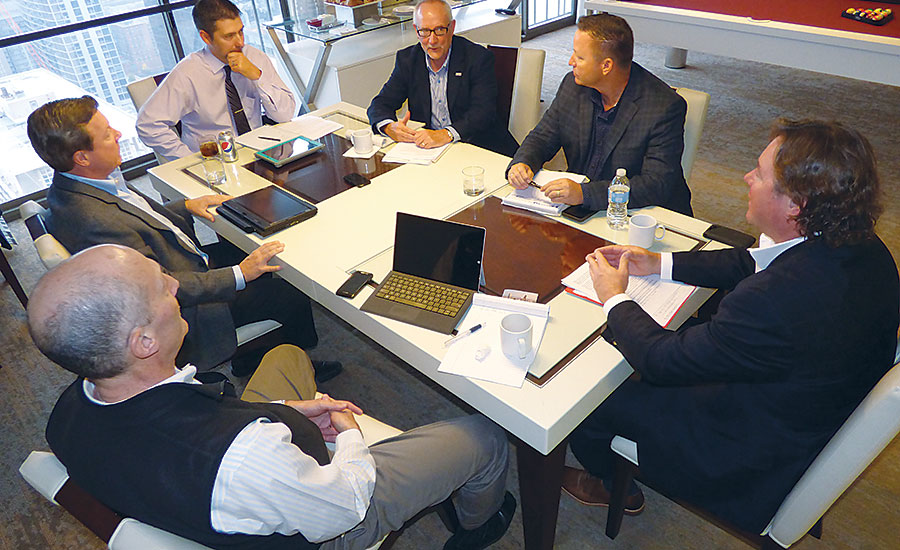Network2015 ASA Roundtable: Part 1
ASA member distributors offer their opinions on hot-button industry topics.

Supply House Times Editor Mike Miazga (top, center) conducts the sixth annual ASA-Supply House Times roundtable interview in Chicago with PHCP-PVF distributors, clockwise, from right: Gary Jones (Eastern Penn Supply Co.), Glenn Fuller (Texas Plumbing Supply), Patrick Sharp (American Precision Supply), Steve Feiger (Crawford Supply) and Bill Glockner (Hirsch Pipe & Supply). Photo by Bob Miodonski/Supply House Times

Hirsch Pipe & Supply’s Glockner says, “Wholesale distribution still remains the best way to get construction products to the professional contractor.” Photo by Bob Miodonski/Supply House Times

Texas Plumbing Supply’s Fuller (right) answers a question as EPSCO’s Jones looks on. Fuller feels any company with more than 10 to 15% of business tied into one customer is risking potential financial Issues. Photo by Bob Miodonski/Supply House Times

Sharp says American Precision Supply has enjoyed recent success in hiring young talent out of smaller universities with an eye on candidates with high academic and athletic backgrounds. Photo by Bob Miodonski/Supply House Times

Feiger (right) says Crawford has a long-term vision in mind when it hires new employees. “We try to hire for the path,” he says. Photo by Bob Miodonski/Supply House Times

The roundtable panelists spent a great deal of time discussing relationships throughout the supply chain. Photo courtesy of ASA. Photo by Bob Miodonski/Supply House Times






In an athletic setting, chemistry among players can be an important factor when it comes to determining team success.
In late October, a distinguished panel of five PHCP-PVF distributors had that chemistry flowing during the sixth annual Supply House Times/American Supply Association roundtable discussion at the Chicago Marriott Downtown Magnificent Mile during ASA’s record-breaking Network2015 event.
The instant chemistry and camaraderie between the five distributors produced a nearly two-hour candid interview session that spanned many industry hot-button topics, including e-commerce, hiring practices, customer credit and distributor relationships with other parts of the supply channel. This year’s roundtable panel featured:
- Steven Feiger, CEO, Crawford Supply Group of Companies, Morton Grove, Ill.;
- Glenn Fuller, President/co-owner, Texas Plumbing Supply, Houston, Texas;
- Bill Glockner, President, Hirsch Pipe & Supply, San Juan Capistrano, Calif.;
- Gary Jones, Marketing Manager, Eastern Penn Supply Co., Wilkes-Barre, Pa.; and
- Patrick Sharp, Vice President, American Precision Supply, Hampshire, Ill.
The second installment of this interview appears in the February issue of Supply House Times.
Question: How are you dealing with the proliferation of e-commerce in the supply channel?
The panelists agreed e-commerce sales continue to increase in the industry, but cautioned there still is great value in dealing with traditional wholesale distribution methods.
“E-commerce is sexy,” Fuller said. “It’s on a computer, can be done from anywhere and it’s clean. You fix up a fancy website and you look great. But there still is that segment that needs wholesale distribution and needs boots on the ground in a local market. There was a buyer at one of our counters recently who was a building maintenance supervisor. He said he bought flush-valve parts online but got the wrong thing. He told us we knew exactly what he needed when he walked into our sales counter. You don’t get that online.”
Feiger added: “If you talk to people in the building business, most will tell you plumbing is their most complicated category. Something such as a faucet might lend itself to e-commerce. But then you take the faucet and put it together with the kitchen sink and the hot-water dispenser and all the other things that go into kitchens and it gets complicated. My belief is the average person is going to depend on us for the knowledge we bring to the table more than if they go online.”
Glockner said more needs to be done in terms of distributors stressing the importance of the traditional brick-and-mortar channel.
“Wholesale distribution still remains the best way to get construction products to the professional contractor,” he said. “Over time, the market for building products has grown and now is split between e-commerce, the home centers and us. Our portion may have shrunk, but the overall pie has grown.
“As distributors we have to work as peers to protect our share of the building products’ market. Some manufacturers may not recognize our importance to the longevity of their brands. Their brands may be put at risk by offerings through the home centers and e-commerce outlets such as Amazon. That hurts distributors in the short term, but potentially puts the manufacturers at greater risk in the long term. We as distributors should be active in our communications with manufacturers about how we can support their brands and add value. When they support us they can protect their brands and maintain their gross margins.”
Fuller added: “We may be competitors in individual markets, but when you are a wholesaler, you are a wholesaler and we need to capitalize on that. This is our industry.”
Question: What strategies have you employed in recent times that have helped move your company forward?
For suburban Chicago-based Crawford Supply, a change in construction segment focus has paid big dividends. “Before the recession we were 75% new construction and 25% remodel,” Feiger explained. “We’ve seen that flip-flop to where we are now 75% remodel and 25% new construction. The ramification for us is more and more business is coming through our showrooms in terms of niche jobs, so much so that I think I would be more inclined to call it a trend. As new construction stays at the level it is at now and more people are inclined to remodel, I think showrooms will continue to play an important role.”
Sharp said the gas distribution market in northern Illinois combined with American Precision Supply’s certification as a woman-owned business (Sharp’s wife, Teri, was profiled in the March 2015 issue) has provided forward momentum in a volatile industrial PVF market.
“Upstream gas distribution has been good for us,” he said. “They are replacing miles and miles of pipe infrastructure in Illinois and we’ve seen a tremendous amount of inquiries in that regard. Since we are WBE (Woman Business Enterprise)-certified, we see that as another great opportunity to differentiate APS. Diversity is becoming more and more important to these larger corporations. It gives us a great avenue as a WBE-certified company to compete for work against these much larger mega-companies in a niche market.”
Question: Has customer credit become an issue of late and how do you manage that aspect of the business?
“When a trade customer is trying to get credit and they’ve extended themselves, we become the bank,” Jones said.
Jones added EPSCO is very aggressive in keeping track of its customer metrics. “We call it the teeter-totter,” he said. “We compare a percentage of sales over a targeted percentage of gross margin against a percentage of sales under a targeted percentage of gross margin. If you are on the high-profit end with something such as showroom sales, you let that go up as far as you want. If it’s the other way, you have to watch it. We have a formula with all the data that allows us to be more aggressive or to back off. We break it down by multiple business segments. You have to be aggressive about this and it takes vision.”
Fuller used the word consistency to describe Texas Plumbing Supply’s business philosophy. “You make sure you don’t have a customer that is too large a percentage of the business,” he said. “We learned a lot from the downturns of 1983 and 2008. If a plumber has 40% of work coming from one builder and that builder goes out, that plumber was gone. My feeling is anybody with more than 10 to 15% tied into one customer is top-heavy and that can be trouble.”
APS, Sharp noted, keeps a close watch on days sales outstanding (DSO) numbers throughout the year. “We’ve passed up some pretty large projects,” he said. “We try to manage our growth and partner with customers we feel best fit our business model. We want to make sure our DSO stays where we feel it needs to be. We are under 40 because we have been very selective on some projects we bid on. We’re focusing on the end user through valve automation (APS has a dedicated automation facility) and value-added services. The margins have been better for us versus that $1 million pipe job that everybody knows about and everybody bids on. It’s never bad to be selective.”
Jones revealed EPSCO’s DSO number has remained in the 30s for quite some time, but not without plenty of effort. “It’s a constant challenge,” he said. “Sometimes there are people who can stretch that out. We’re really tight on it.”
Sharp added APS’ commissions are paid after receipt of payment. “Our salespeople need to be selective and smart with who they are partnering with,” he said. “It’s exciting to see those huge jobs and large-volume orders, but if you don’t collect, it can be detrimental to your company.”
Question: How are you approaching hiring new talent into your company?
Earlier in the interview, Feiger cited a statistic that shows the average age of a plumber in the country is 58. Similar statistics over the last year continue to show a mature wholesale-distribution workforce as well, thus bringing out the urgency to hire young talent for the future. “The talent hunt is far more intense than it has been in the past and I think it’s going to get even tougher,” Feiger said.
Crawford Supply looks for talent through many different channels, including online job boards. “You have to be out in multiple areas and even then you never know where potential hires could come from,” Feiger said.
Hirsch Pipe & Supply employs the use of a comprehensive management training program as part of its hiring process. “We’re trying to find that person who has potential within a five-year period,” Glockner said. “Before, it might take 10 years for a person who starts as a driver to rise into a management position. For a company of our size, we can’t afford a national training classroom with recruiting classes based on what our needs are at the moment. We’re looking for that person who is open to new challenges and understands the fundamentals, and who can be effective managing people down the road.”
APS hired three 23-year-old salesmen from a smaller university last year. “The first 10 years we were in business we struggled with hiring the right new people,” Sharp said. “We tried hiring people who have been in the industry for years and we were not very successful. Now we focus on small universities and are going after very high academics. Our recent hires had grade-point averages of 3.8 and above. We’re also focusing on athletes. They have great work ethics, are coachable and are willing to be taught. They also get the team dynamic. They understand everyone in the company is integral to their success.”
The panelists agreed using a strategy of hiring based on a specific job title may not be the right way to go in today’s business climate. “When we are hiring a driver, we really should be trying to find a sales trainee,” Glockner said. “More and more we want someone with character and potential, whereas before we may have weighed industry experience more heavily.”
Feiger added: “We can teach product. We can’t teach attitude. It’s real simple. We don’t hire for the position. We try to hire for the path.”
Many of the panelists lauded ASA for its continued help in establishing recruitment and hiring programs for its member companies.
Question: How have relationships evolved with other parts of the supply chain such as manufacturers, reps and master distributors?
This question, touched on briefly in the earlier conversation about e-commerce, took up a healthy chunk of the interview and elicited many strong thoughts and opinions. The first part of back-and-forth dealt with master distributor relationships.
“Fifteen years ago we could buy from mills,” Sharp said. “It seems many mills only are dealing with the masters and the mega distributors. So now you have to go to the master to get certain materials.”
Jones added: “Masters provide a very important service for us, but you have to be a watchdog and make sure they don’t go around to your customers.”
Sharp said he recently ran into a situation where a master did sell to one of his customers. “It’s a huge concern,” he said. “When the economy is down and they are sitting on millions of dollars of inventory, they have to move it. In the past, we weren’t able to buy container loads. Going to the master was a way for us to level the playing field with some of the bigger companies. I believe most do not sell direct but some do. Are we customers or competitors? I think with some, it’s both.”
In terms of manufacturers reps, panelists said they would like to see more product training at that level. “The reps really aren’t compensated for training in the field,” Glockner said. “Our branches need support and training to reach their full potential on a product line. Most reps aren’t set up for that. Their salespeople want to come in and take an order and that often does not happen at a twig of a multi-branch wholesaler.”
Sharp said sales reps are being stretched thin and feels recent consolidations could have something to do with that. “We’re seeing a lot of consolidation and then it becomes an accounting-based philosophy,” he said. “It used to be twice a year that we would send employees to train at manufacturers’ facilities, but many do not offer that anymore. They don’t have the people to do it. In the past, a company may have had 15 reps and now you have a guy covering the east and a guy covering the west.”
Jones and Sharp noted both their companies are aggressive in grading their reps and providing feedback. “We really need our sales reps help to make us experts on their products,” Sharp said. “They aren’t helping us if they come in and read a catalog. Fortunately, we have excellent sales reps working with APS.”
The topic of stocking buy-sell reps entered into the conversation and panelists again elicited some strong thoughts on the practice. “We have stocking reps with numerous lines who will package them together at the best discount and at favorable freight requirements or they may even allow pickup,” Jones explained. “Compare that to buying directly from the manufacturer at the same or similar discount and equal or higher freight requirements for one line. You sometimes wonder what the advantage is buying direct. That’s where it bothers me a little. The stocking rep should have the same full-freight requirements as the vendor. It’s an issue we’ve run into. It allows the non-stocking distributor to be competitive with the stocking distributor.”
Feiger added: “We’ve wrestled with stocking reps forever. More interesting is the impact when manufacturers start hitting all these channels. The impact it has on the brand is potentially negative and I’m not sure if manufacturers recognize that.”
The panelists wrapped up the extended conversation by circling back and discussing in more detail the fragmentation of the supply channel.
“You walk into a Lowe’s and see a 25-ft. display for a product you are stocking and it basically says get rid of the plumber and do it yourself,” Fuller said. “What the manufacturer is doing is driving business away from us. They are selling a product for a much higher price there. That doesn’t help us. Drive your product through me.”
Glockner labeled the current climate as a “strange new world.” “More and more manufacturers are active in multiple channels and many have overlapping product offerings; there’s no more exclusivity or even semi-exclusivity in distribution,” he said. “At the same time, some manufacturers get upset if a distributor considers private label or supporting multiple brands. Channel conflict is everywhere. More and more, the wholesaler has to show manufacturers how they are partnering with their brands by investing in demand creation, application support for customers and e-commerce integration.
“We have to stress how other channels don’t bring as much long-term value or profit potential for their brands. Overly broad distribution through e-commerce and the home center is not always the optimal strategy, especially if it ends up reducing the overall investment in inventory and sales support for their brand in the marketplace.”
Next time, the panel tackles topics such as succession planning, government affairs, the economy and their thoughts on the role ASA is playing in today’s PHCP-PVF industry.
This article was originally titled “Straight Shooters” in the January 2016 print edition of Supply House Times.
Looking for a reprint of this article?
From high-res PDFs to custom plaques, order your copy today!












